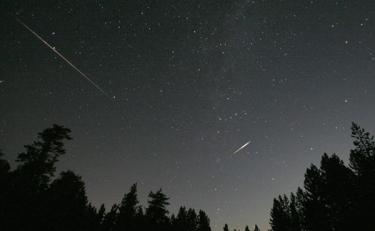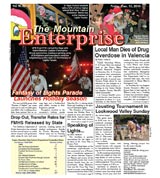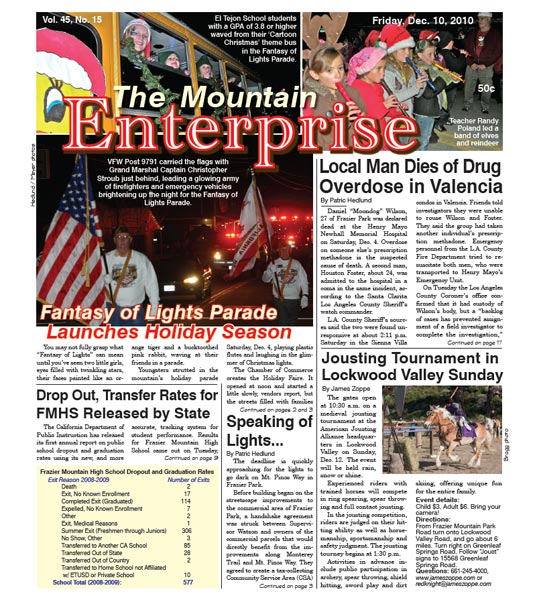
In August 2009, Mario Anzuoni took this image of meteors from the Perseid shower shooting across the sky above the Los Padres National forest near Frazier Park. This image was printed in The Irish Times.
Update: On the Winter Solstice, December 20-21, there will be a total lunar eclipse. The darkest part of the eclipse – the umbra – starts (in California’s Pacific Time Zone) about 10:30 p.m. and ends at about 2 a.m. Totality – when Earth’s shadow completely covers the moon – will last from 11:40 p.m. to about 1 a.m. The moon will be high overhead during the eclipse.
The Mountain Communities often hosts knowledgeable amateur astronomers. Carl Hergenrother, an astronomer with the University of Arizona, recommends finding the darkest skies with the fewest obstructions, getting away from city lights, buildings and trees " in places with pitch black skies, without light pollution." The parking lot at the top of Mount Pinos is a famous place for observing such events, attracting visitors from around the world.
Local Starry Skies Will Showcase Annual Geminids Meteor Shower and a Total Lunar Eclipse
Universities and astronomy clubs are buzzing with reminders that early Tuesday morning, Dec. 14, our skies will showcase one of the best events of the year in the Southwest.
The Perseids meteor showers in August are the most famous, but the Geminids are unique and often exciting if our mountain skies above the Frazier Park and Mountain Communities are clear. Because we are surrounded by the Los Padres National Forest, light pollution is still lower here than in other parts of Southern and Central California. Stargazers often gravitate to Lockwood Valley, Pine Mountain and the top of Mount Pinos for these kinds of celestial events.
Carl Hergenrother, a senior researcher at the University of Arizona Lunar and Planetary Laboratory, predicts that you will see meteors after about 10-20 minutes of observing.
In a dark sky, Hergenrother said, the Geminids have been known to produce rates of up to 120 meteors per hour at their peak—two per minute. Unlike most meteor showers that can only be observed in the early hours of the morning, the Geminids’ radiant ( the point in the sky from which meteors appear to originate) rises as early as 6 p.m. and a good number of meteors can be seen by 9 p.m.
According to the University of Arizona alerts (but adjusted to Pacific Time) "the radiant is nearly overhead at 2 a.m. and well-placed for the rest of the night. This year the first quarter moon (located close to a brilliant Jupiter) will hinder Geminids watching until it sets at about 11:45 a.m."
"Hergenrother said a few early Geminids have been seen during the past week, but the peak night, Dec. 13-14, should be the best. Starting in the evening, look to the northeastern sky. The Geminids appear to radiate from the constellation of Gemini, specifically near the bright star Castor, the northern star in the Castor-Pollux pair. By the middle of the night, the radiant will be nearly overhead and meteors will be raining down on all sides.
"Rather than looking directly at the radiant, it is easier to see meteors by looking 30 degrees or more away from the radiant. For reference, 10 degrees is about the width of a hand held at arm’s length. The key is to look up and you should see quite a few Geminids."
The parking lot at the top of Mount Pinos is a famous place for observing meteor showers, attracting visitors from around the world. Hergenrother recommends finding the darkest skies with the fewest obstructions, getting away from city lights, buildings and trees. "It is in places with pitch black skies, without light pollution, that you may see as many as 120 meteors an hour once your eyes have adjusted. "The rate will be a bit lower in rural areas near small towns…In major urban areas it could be as few as two to 10 per hour," Hergenrother said.
On the Winter Solstice, December 20-21, there will be a total lunar eclipse. The darkest part of the eclipse – the umbra – starts (in California’s Pacific Time Zone) about 10:30 p.m. and ends at about 2 a.m. Totality – when Earth’s shadow completely covers the moon – will last from 11:40 a.m. to about 1 a.m. The moon will be high overhead during the eclipse.
This is part of the December 10, 2010 online edition of The Mountain Enterprise.
Have an opinion on this matter? We'd like to hear from you.


